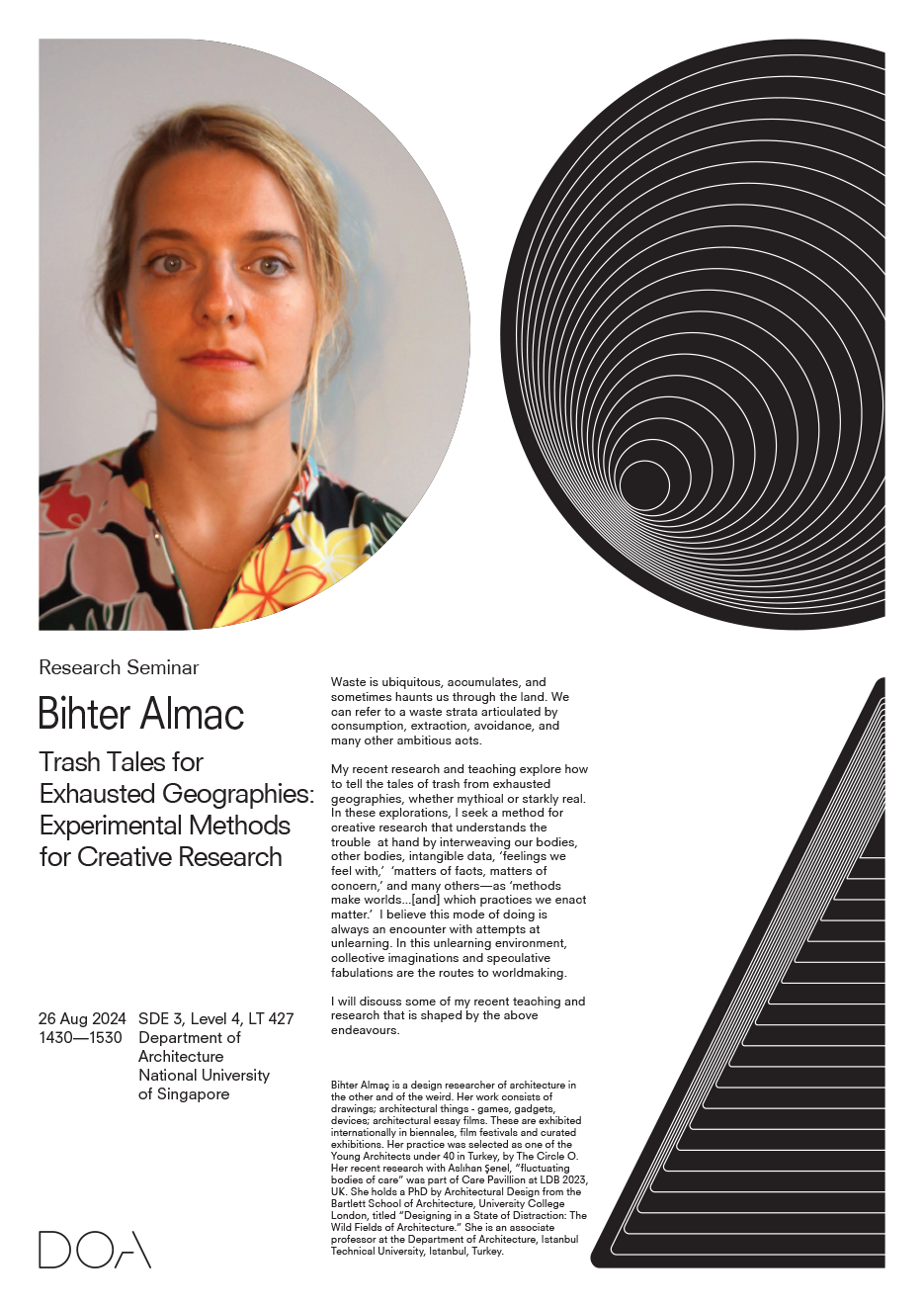Trash Tales for Exhausted Geographies: Experimental Methods for Creative Research
Name of Event/Lecture
Trash Tales for Exhausted Geographies: Experimental Methods for Creative Research
Name of Speaker
Bihter Almac
Location
SDE3 Level 4 LT427

You are cordially invited to attend the research seminar by Bihter Almac:
Date: Monday, August 26th 2024
Time: 2:30 PM – 3:30 PM
Venue: SDE3 Level 4 LT 427
Trash Tales for Exhausted Geographies: Experimental Methods for Creative Research
Waste is ubiquitous, accumulates, and sometimes haunts us through the land. We can refer to a waste strata articulated by consumption, extraction, avoidance, and many other ambitious acts. My recent research and teaching explore how to tell the tales of trash from exhausted geographies, whether mythical or starkly real. In these explorations, I seek a method for creative research that understands the trouble[i] at hand by interweaving our bodies, other bodies, intangible data, ‘feelings we feel with,’[ii] ‘matters of facts, matters of concern,’ and many others—as ‘methods make worlds…[and] which practices we enact matter.’ [iii]I believe this mode of doing is always an encounter with attempts at unlearning. In this unlearning environment, [iv] collective imaginations and speculative fabulations are the routes to worldmaking.
I will discuss some of my recent teaching and research that is shaped by the above endeavours.
I.
Firstly, I will discuss three architecture essay films from the graduate course that respond to exhausted geographies. They are attempts to disentangle three zones of sacrification using feminist research methods in design.[v][vi] These zones have no similar tales, and their sacrifice is undoubtedly debatable by many others. Ecosocial imaginaries have already been performing their course in our everyday lives. In these films, we reconcile and hone our scholarly approach. We are worlding[vii] a realm that extends from the virtual screen of a terracotta archive to the veins of marble stone and a buffalo’s sweat glands.
II.
The second research is about two undergraduate design studios where the aim was to explore the ubiquitous waste and trash, the wasted and overlooked meanwhile to question the formation of architecture and its practices. Thus, these projects were proposals of latent moments of architecture’s othered presence[viii]; its gestures and struggles of remaining at the exterior by curiously drawing and recording, drifting between all the absurdities that our thick present drives us to. They were the manoeuvres of critical, situated making among the trash peaks and debris. These architectures were in denial of their existence, struggling to respond to the responsibilities of architecture programs and their technical promises yet profusely deliver them.
Therefore these studios are truly Kafkaesque. They had the top qualities of pristine architecture, yet it witnessed their experience of a struggle for gradual unbecoming. They were attempts among the heaps of trash, excessive gestures of consumption, piles of debris, and pollution of the guilty afterthought. They are highly aware of common practices of architecture where greenwashed capitalism pretends to offer solutions. And, they emancipate a future where unbecoming, deterioration, and ephemeral are the key to the resilience of this thick present.
Bihter Almaç is a design researcher of architecture in the other and of the weird. Her work consists of drawings; architectural things – games, gadgets, devices; architectural essay films. These are exhibited internationally in biennales, film festivals and curated exhibitions. Her practice was selected as one of the Young Architects under 40 in Turkey, by The Circle O. Her recent research with Aslıhan Şenel, “fluctuating bodies of care” was part of Care Pavillion at LDB 2023, UK. She holds a PhD by Architectural Design from the Bartlett School of Architecture, University College London, titled “Designing in a State of Distraction: The Wild Fields of Architecture.” She is an associate professor at the Department of Architecture, Istanbul Technical University, Istanbul, Turkey.
[i] Haraway, Donna J., Staying with the Trouble : Making Kin in the Chthulucene. (Durham: Duke University Press Books, 2016).
[ii] Boler Zaliwska, Zofia Megan, ‘Troubling Hope: Performing Inventive Connections in Discomforting Times’, Studies in Philosophy Education, no. 38 (2019): 71–84, https://doi.org/10.1007/s11217-018-9630-7.
[iii] Barad, Karen, Meeting the Universe Halfway Quantum Physics and the Entanglement of Matter and Meaning (Durham: Duke University Press Books, 2007); Haraway, Donna J., Staying with the Trouble : Making Kin in the Chthulucene.; Coleman, Rebecca and Jungnickel, Kat, ‘Introduction to Creating Feminist Futures: Research Methodologies for New Times’, Australian Feminist Studies, 10 July 2024, https://doi.org/DOI: 10.1080/08164649.2024.2373931.
[iv] <https://newmaterialism.eu/almanac/f/feminist-new-materialist-pedagogies.html> Accessed by 01.07.24.
[v] Posthumanist feminist approach intrinsically embeds both feminist critique of the humanist approach and the postanthropocentric approach towards ecological crisis Braidotti, Rosi, ‘Posthuman Feminist Theory’, in The Oxford Handbook of Feminist Theory, ed. Lisa Disch and Mary Hawkesworth, n.d., 673–98.haraway
[vi] Rendell, Jane, ‘A Way with Words: Feminists Writing Architectural Design Research’, in Design Research in Architecture: An Overview, ed. Fraser, Murray (London: Routledge, 2016), 117–36; Chee, Lilian, ‘Reimag(in)Ing Domesticity in 03-FLATS: Single Women and Singapore Public Housing.’, in Making Visible: Architecture Filmmaking (London: Intellect Books, 2019).
[vii] Haraway, Donna J., Staying with the Trouble : Making Kin in the Chthulucene.
[viii] Stoner, Jill, Towards a Minor Architecture (New York: MIT Press, 2012).